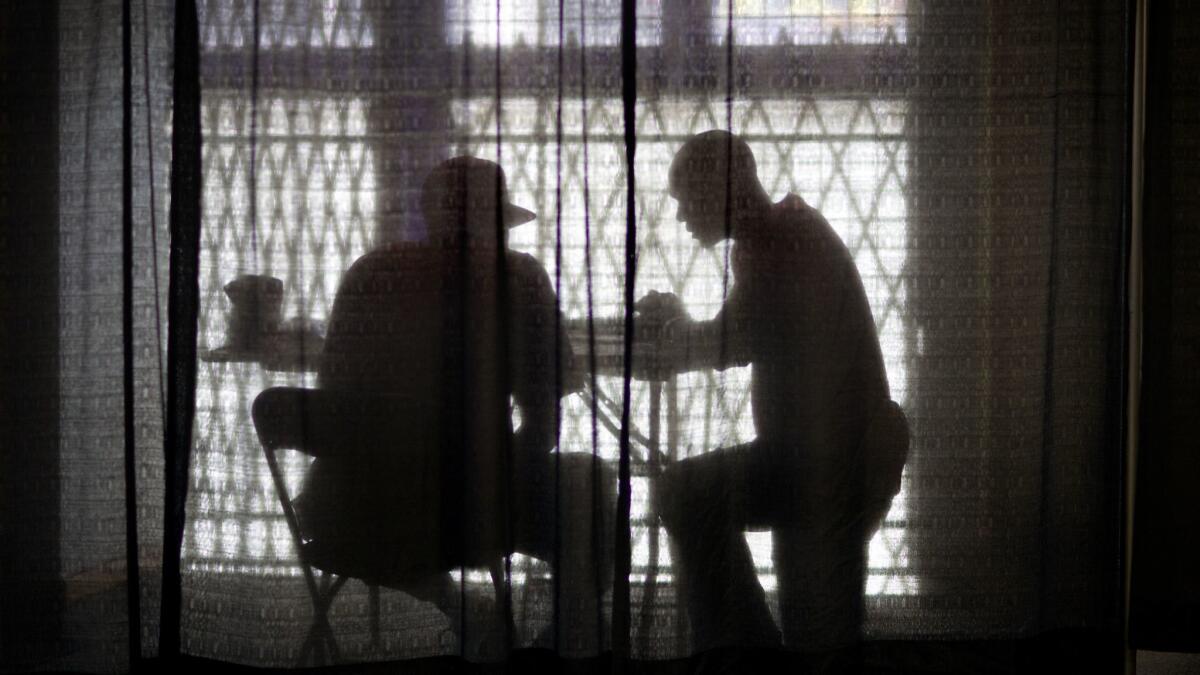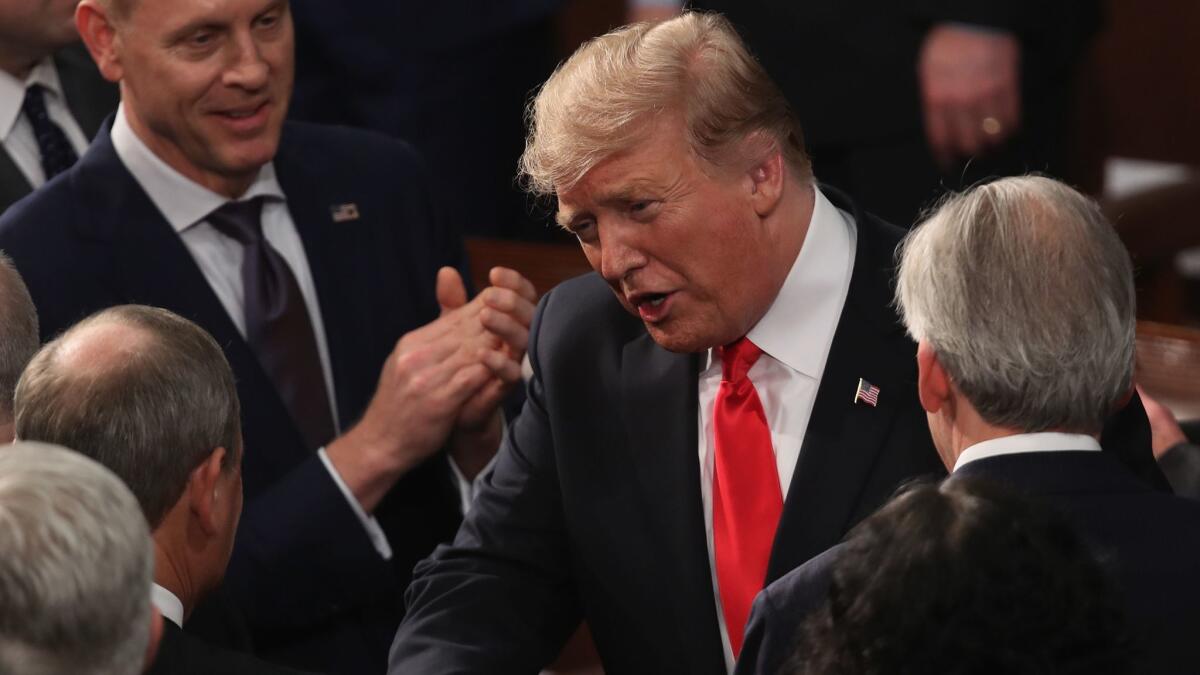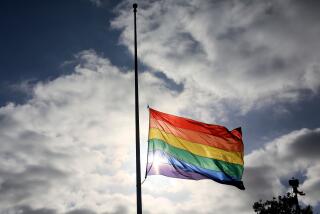Global Development: Halting HIV by 2030 is a challenge. Here’s why it’s especially tough in the South

Reporting from ATLANTA — By midmorning, a line snaked out the door of AID Atlanta’s Midtown clinic. It was National Black HIV/AIDS Awareness Day, and the waiting room was packed with people — a worker in an orange safety vest, a mother cradling a toddler, a man in a navy suit — waiting to be tested.
Downstairs, Ted Krug, a volunteer with the Georgia AIDS and STI Information Line, picked up the telephone and tried to calm a 54-year-old woman who was panicking because she’d had unprotected sex with someone she later learned was bisexual.
In her office cubicle, medical case manager Carla McCray checked the time. A client, 22 and without health insurance, had not shown up for his appointment to apply for federal funds for HIV drugs. She called his cellphone to ask what was going on, but got no answer.
In his State of the Union address earlier this month, President Trump announced a plan to halt the transmission of HIV in the United States by 2030. But clinics across the country face a knot of obstacles to meeting that target. The problems are most severe in the Southeast, currently the epicenter of the nation’s HIV epidemic.

“We have the technology, we have the expertise, to prevent HIV and allow those who unfortunately contract it to live healthy and productive lives,” said Nicole Roebuck, executive director of AID Atlanta, an agency that has provided HIV/AIDS-related services and care since 1982. “But the funding is never enough, and the stigma in the South is still a debilitating factor, especially for people of color.”
The number of new HIV infections across the United States dropped from about 130,000 in 1985 to 50,000 in 2010, and has plateaued at around 40,000 in recent years. Among intravenous drug users, the infection rate has jumped from 6% to 10% since 2015.
While the nation’s first cases of AIDS were documented in San Francisco, Los Angeles and New York City in the early 1980s, Southern states now make up 52% of new HIV diagnoses — up from 44% in 2014. Miami ranks as the nation’s top metro area for the rate of new HIV diagnoses, followed by Orlando, Fla., Atlanta, New Orleans and Baton Rouge, La.
Healthcare advocates say the structural and political challenges to combating HIV/AIDS are greater in the rural South, where public transportation systems are lacking and schools are less likely to educate students on prevention options.
Laws that criminalize HIV exposure in more than 25 states also may make people reluctant to get tested. In Louisiana, for example, a person living with HIV who knows their status and intentionally exposes another through sexual contact can face 10 years in prison.
If the Trump administration is serious about eliminating HIV, many experts say, it must increase federal funding for prevention efforts and reverse several key areas of its healthcare policy, such as efforts to gut the federal Affordable Care Act, oppose the expansion of Medicaid and push abstinence-only sex education.
“Trump’s war on the Affordable Care Act, his policies that would make it harder for people to get on or to stay on Medicaid, work against the first step in controlling the epidemic,” said Gregg Gonsalves, assistant professor of epidemiology of microbial diseases at Yale School of Public Health.
“If you look at the map of HIV rates and pull up another map of Medicaid expansion states, guess what?” he added. “Many of the states that didn’t extend Medicaid or [that] put work requirements into place are the states that are struggling with HIV.”
According to Alex Azar, secretary of Health and Human Services, the federal government aims to reduce new HIV infections by 75% over five years and 90% in the next decade.
The initiative will focus on 48 counties where transmission is high. Trained public health workers will tackle hard-hit geographic “hot spots,” offering more testing options and drug therapies to at-risk populations — such as minorities, and men who have sex with men. It will also target seven states (Alabama, Arkansas, Kentucky, Oklahoma, Mississippi, Missouri and South Carolina) where 10% or more of the HIV population lives in rural areas.
Carolyn McAllaster, a law professor at Duke University and director of the university’s Southern HIV/AIDS Strategy Initiative, said she was thrilled to see officials home in on rural pockets of the Deep South, which traditionally have seen little funding.
Still, she said, any plan to end HIV has to involve providing comprehensive, equitable healthcare.
“If we don’t expand Medicaid in our Southern states, it’s going to be very difficult to eradicate HIV,” she said.
Stopping the virus’ spread should be achievable, the vast majority of experts agree, because treatment exists: People diagnosed with HIV can undergo antiretroviral therapy that lowers the amount of the virus they carry to almost zero and prevents transmission to partners. People who do not have HIV, but are at substantial risk of contracting it, can prevent infection by taking a daily pill — a practice known as pre-exposure prophylaxis, or PrEP.
But only about half of HIV-positive people in the U.S. are receiving antiretroviral treatment. And PrEP is expensive.
Many diagnosed with HIV or those considered at risk face barriers — low wages, limited transportation options, unstable housing — that compound the challenges of getting care.
“HIV is an epidemic that is entrenched in poverty and inequality,” said Dr. Melanie Thompson, principal investigator at the AIDS Research Consortium of Atlanta. “You cannot separate the inequalities — the racism, the homophobia, the transphobia — from this epidemic. It drives the epidemic.”
There is scant federal funding for PrEP. And while the drug’s manufacturer, Gilead Sciences, offers an assistance program for patients who cannot afford to pay up to $2,000 a month, many struggle to cover the cost of visiting a doctor or paying for regular lab testing.
“We can do everything we can to have the services that they need, but the funding is never enough,” Roebuck said. “People have to make all kinds of choices: ‘Should I pay my rent or should I take my meds?’ ‘Do I spend $2.50 to travel to the clinic or do I buy a sandwich?’”
L.A. County officials launch effort to curb HIV »
Medicaid covers the costs for an estimated 40% of those receiving HIV treatment in the United States. According to a 2014 report funded by the drug industry, about 60,000 low-income, uninsured people with HIV/AIDS live in states that did not expand Medicaid under an optional provision of the Affordable Care Act, widely known as Obamacare.
When Louisiana expanded Medicaid in 2016, many people with HIV found it easier to locate a doctor and seek treatment, said Gina Brown, community engagement manager for the Southern Aids Coalition in New Orleans.
“It opened up choice,” she said.
While Trump plans to ask Democrats and Republicans to commit to eliminating the HIV epidemic, he did not specify how much money he will request or whether it will come from existing programs or new appropriations. The White House is scheduled to release its annual budget request to Congress next month.
Many who run clinics say substantial new funding is needed to reengage the thousands of people who are not getting regular medical care.
About 15% of Americans with HIV don’t know they’re infected, CDC report says »
“We are already stretching beyond our seams,” said Dr. Wendy Armstrong, medical director of Grady Health System’s Ponce de Leon Infectious Disease Center in Atlanta. One of the largest HIV-care providers in the U.S., it offers complex care to more than 6,200 patients.
The clinic, which focuses on advanced HIV/AIDS, started a rapid-entry program in 2016 to try to provide appointments and start patients on drugs within 72 hours — and ideally within the same day. But soon staffers were inundated with hundreds of new patients and had to shut down the program. They recently restarted it but are struggling to cope, with just 15 full-time physicians, nurse practitioners and physician assistants.
Dr. Hansel Tookes of the University of Miami’s Miller School of Medicine has spent the last few years pioneering Florida’s first syringe-exchange program, which swaps fresh needles for drug users’ old ones. But he is still working to persuade Florida legislators to expand the program.
“People who inject drugs — that’s where the emerging challenge is,” he said. “But the South lags behind.”
Ultimately, many care providers say social stigma remains the trickiest hurdle to ending the HIV epidemic.
“We’re still not talking about sex in Mississippi,” said Deja Abdul-Haqq, director of organizational development at My Brother’s Keeper in Jackson, which founded the first LGBTQ heath center in the state.
“We’re not talking about it in the Legislature, we’re not talking about it in the schools and we’re not talking about it in the church,” she said. “In order to talk about HIV, you have to talk about sex.”
More to Read
Sign up for Essential California
The most important California stories and recommendations in your inbox every morning.
You may occasionally receive promotional content from the Los Angeles Times.











